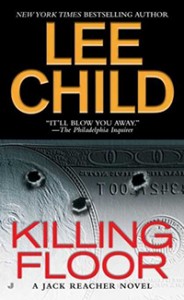Killing Floor, by Lee Child. New York: Jove Books, 1998.
536 pp. $9.99 (paperback).
“I was arrested in Eno’s diner. At twelve o’clock. I was eating eggs and drinking coffee. A late breakfast, not lunch. I was wet and tired after a long walk in heavy rain” (p. 1).

This is the scene in which Lee Child introduces the world to Jack Reacher, an American wanderer and former homicide investigator with the military police who manages to get himself into all kinds of trouble, despite his efforts to avoid it.
Even with only these opening lines of Killing Floor—Child’s first novel, originally published in 1997—we get a sense of Reacher’s character. He is a man who likes to get to the point. He narrates in concise statements. He is rarely ruffled, never intimidated.
Reacher, tired of his regimented military life—he was born on a military base in 1960 and never left the military until six months before the novel begins—decides to try the freedom of the open road. He wants to go where he pleases, see the country, and not get tied down. His only stable contact is his bank, which wires him cash from his military pension and sends him mail.
On a whim, Reacher wanders into Margrave, Georgia, to learn the story of a long-deceased musician called Blind Blake, whom his brother had mentioned to him in a letter. His plan is to look around, get the lowdown on Blind Blake, then hop on a bus and leave.
Unfortunately, Reacher wanders into town around the time police discover the bodies of two men, brutally murdered, found near the highway where Reacher got off the bus. Plenty of people saw him walking near the scene of the crime. So, he is arrested for murder.
Initially, Reacher’s goal is to beat the murder rap and leave town as quickly as possible. Unfortunately for his plans—but fortunately for those seeking justice—Reacher learns that the murders are part of a bigger crime, a crime that, unexpectedly, involves someone he knows. After beating the rap, Reacher decides to stick with the case and help solve it. And it doesn’t hurt that one of the local officers is an attractive lady named Roscoe who enjoys Reacher’s company.
Over the course of the story, Reacher acquires several enemies who would like to see him stop breathing. But he is a large, muscular man with a military training and a police background—not to mention a survival mentality—so he is not easily pushed around, threatened, or injured. We learn this early on, when Reacher finds himself “accidentally” placed with the most violent inmates of a prison rather than on the holding floor. Without revealing too much, I can hint that things do not go as planned for the prisoners who attack him.
If you want to know what Jack Reacher is about, consider his thoughts about one of his associates who has just agreed to accompany Reacher on a mission: “He had stopped worrying and started relaxing. He was up on that plateau where you just did whatever needed doing. I knew that place. I lived there” (p. 470).
I read the first Reacher novel after seeing the film based on a later Child book. (Child has written seventeen Reacher novels in all and has another one on the way.) Some of my friends had enjoyed the novels, so I decided to give them a try. I was not disappointed. The action is fast-paced; the characters are interesting; and Reacher, although not the most likable guy, is a supremely competent man, the sort of guy anyone would want beside him in a fight.
Reacher’s competence is what makes him appealing as a character. Whether he is physically fighting with hooligans, verbally jousting with police, investigating a crime scene, or analyzing a technical book on finance, Reacher knows what he is doing—and he does it efficiently, usually with a calm demeanor. Even when he grows angry or disturbed, he keeps his wits about him and does “whatever needs doing.”
Child spins a plausible story. The villains are motivated by realistic criminal desires, and Reacher acts in ways that, although amazing, are believable.
The only significant problem with the novel is that it relies on a couple of coincidences for its plot. As Reacher himself acknowledges, his connection to the crime scene is just a “crazy coincidence” (p. 204), as is an association of one of Reacher’s new partners. (I cannot give away details without spoiling the story.) But these coincidences are not so implausible as to significantly undermine the story.
Killing Floor is a crime story. There’s nothing deeper to it than a man of good character and ability fighting to take out bad guys and achieve justice—while pushing and sometimes ignoring legally defined boundaries. But Jack Reacher doesn’t need anything deeper than that to be a hell of an entertaining character.


![[TEST] The Objective Standard](https://test.theobjectivestandard.com/wp-content/uploads/2017/10/logo.png)














